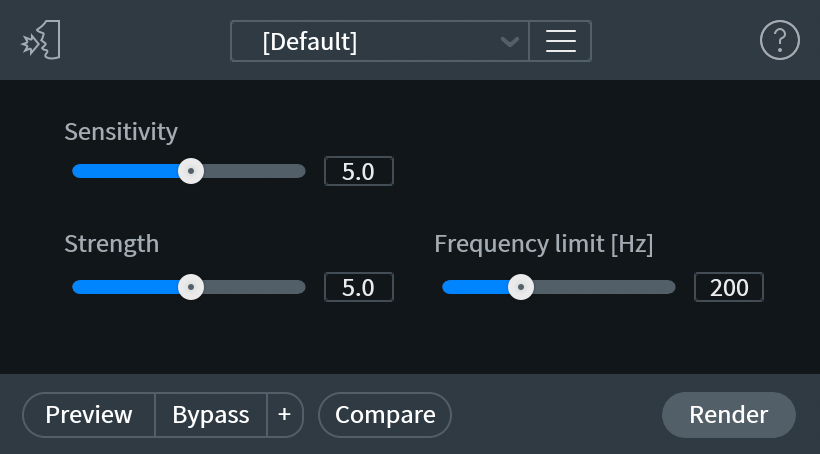De-plosive
STD & ADV
Module & Plug-in
Overview
A plosive is a consonant speech sound that occurs when the vocal tract briefly blocks the flow of air during speech. When the block in the vocal tract is resolved, an audible release of pressure occurs, called a plosive. Pop filters (in a studio) or wind filters (on location) are commonly used when recording vocals or dialogue, in order to reduce the popping effect that can occur when the higher pressure plosive signal comes into contact with the diaphragm of a microphone.
De-plosive can intelligently identify, separate and reduce plosives in an input signal while still preserving the fundamental frequency content and harmonics of the dialogue.
Controls
The following section describes the controls available for refining plosive reduction.

Sensitivity
Adjusts how much of the input audio will be categorized as a plosive. Sensitivity has a greater effect on the overall effectiveness of plosive reduction than simply increasing the Strength control.
- Lower values will instruct the algorithm to narrowly define what it will detect as a plosive. This may result in less overall reduction of plosives with the benefit of maintaining the quality of the speech signal.
- Higher values will instruct the algorithm to more broadly detect plosives in the input signal, which may result in too much of the speech signal being identified as, and subsequently reduced with, the plosive signal content.
Strength
Adjusts the amount of reduction applied to the detected plosive signal content. Higher values can result in significant plosive reduction at the cost of decreasing the quality and clarity of the speech signal. To maintain the speech signal while still reducing plosives, try increasing the Sensitivity control and decreasing the Strength control.
Frequency Limit [Hz]
Sets the upper frequency boundary for plosive reduction. Plosives typically manifest between 20Hz to 300Hz, but may sometimes reach as high as 500Hz. Setting this control just above where the plosives are occurring in the input signal can help reduce unwanted reduction of frequency above where the plosives are occurring.
Identifying plosives in the spectrogram display
The spectrogram can be used to help determine the highest plosive frequency in the input signal. Plosives are caused by small bursts of air pressure hitting the diaphragm of a microphone which results in an increase in amplitude. The colors used to represent signals in the spectrogram are tied to the amplitude of a signal. Darker colors represent lower amplitudes and brighter, more vibrant colors represent higher amplitudes. Plosives will generally appear brighter than the signal content that surrounds them.
Recommendation: Use De-plosive before applying a high pass filter
De-plosive attempts to detect plosives between 20 to 80 Hz. If the input file has already been filtered with a high-pass filter, it is possible that plosive detection will not function correctly. To achieve the best results, it is recommended that De-plosive be used before applying a high-pass filter.